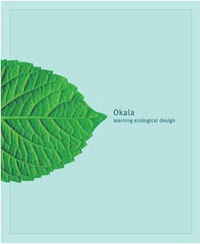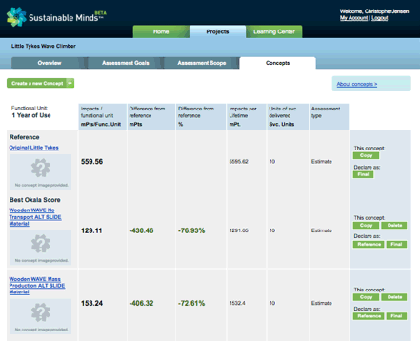 This post by guest contributor Steve Puma, a sustainability and personal technology consultant, first appeared on Triple Pundit. His personal blog, ThePumaBlog.com, deals with the intersection of sustainability, technology, innovation, and the future.
This post by guest contributor Steve Puma, a sustainability and personal technology consultant, first appeared on Triple Pundit. His personal blog, ThePumaBlog.com, deals with the intersection of sustainability, technology, innovation, and the future.
Paper or plastic? Diesel or hybrid? Extrude or blow-mold? Some of the most difficult problems in designing sustainable products involve making the right choices in materials, processes and transportation methods. However, choosing the options that will actually have a lower environmental impact is much more complex that one would think.
Deciding what metrics to use, where to draw the boundaries and how to compare wildly different materials is a highly involved and technical art known as Life-Cycle Analysis, or LCA. Sustainable Minds, a Boston-based software company, is making LCA much more accessible to designers with its new web-based software service. I was recently able to see the software in action at a seminar entitled, “Mastering Environmental Impact Assessment in the Design Process.”
As Pratt Institute professor and ecologist Christopher X J. Jensen, Ph.D., explains, while quantitative methods, such as LCA are the best ways to measure the environmental impact of a product, these methods need to be applied by scientists, and do not jibe well with the qualitative methods generally used by designers to evaluate the aesthetics of a product design.
While qualitative analysis may be an appropriate method to judge aesthetics,
“for a design to be truly labeled as “more sustainable” than another, it has to be judged quantitatively. Judging the sustainability of a designed object based on qualitative comparison is dubious at best, and often leads to the promotion of a design or practice that actually has a greater environmental impact than other alternatives. We call this “greenwashing”, and it is important to note that greenwashing does not need to involve intentional obfuscation; any claim of lowered impact or “sustainability” that is not based on quantitative analysis could be wrong, and therefore could be a form of greenwashing.”
The Sustainable Minds application, currently in private beta, attempts to bridge the gap between these two worlds of design and environmental science, by utilizing a process based on Okala, a comprehensive design education project of the Industrial Designers Society of America. Okala developed several concepts which make LCA accessible to designers:
- Relative impacts: There is no such thing as a 100% sustainable product, because all products have some impact on the environment. Product sustainability must be evaluated in relation to other products.
- Okala Impact Factors: Using the newest environmental impact characterization methods and normalization data from the US EPA, as well as the newest weighting values from the National Institute of Standards and Technology (NIST), Okala Impact Factors enable estimation of the ecological performance of any product or system.
- Sustainable Design: While “ecological design” is economically viable and environmentally benign, sustainable design include those plus requiring a product to be socially equitable.
At the present time, the Sustainable Minds software is able to evaluate Okala Impact Factors for approximately 240 materials and process, covering the bulk of currently available design choices for North American products. The continuously updated factors allow design teams to perform what-if comparisons based on 10 impact categories, or compare just global warming impacts, measured in CO2 equivalents.
To use the software, designers create a “project” which is a container for multiple design “concepts”. Each concept is a particular implementation of an idea in which the designer can make different choices in materials, processes and transportation options. The software allows for consideration of the impacts of the use and disposal phases. All of these factors go into a “system bill of materials” (SBoM), which is everything that is creating an environmental impact within the “system boundary” of the analysis.
All of the concepts within a particular project are being evaluated upon the exact same criteria, yet there is plenty of room to expand or shrink the analysis. Do you want to know all possible impacts of your designs, from cradle-to-grave? Simply expand the system boundary to include the use and disposal phases. Want to know what will happen if you change something small, like going from steel fasteners to aluminum? Copy a concept and change that one component. The interface shows all of the concepts side-by-side, with the easy-to-interpret Okala impact numbers and global warming numbers displayed in large text.

In many cases, the design choice with the least environmental impact may be quite counter-intuitive. What makes the Sustainable Minds software such an excellent and valuable tool is the way that it reduces these complex choices into a few easy to compare numbers. During the class, I was able to experience this firsthand. Along with a group of four others, I was tasked with using the software to develop three new concepts for a children’s plastic backyard play set, and then evaluating the impacts of those concepts.
It quickly became apparent that our instinctual assumptions about what is “good” and what isn’t does not always match with reality. Our first attempt was a sort of hedge maze, shipped as a biodegradable framework upon which grass and other plants would grow. Of course, this concept turned out to be the least sustainable, requiring a lot of water and yearly replacement. But what was really shocking was the overall environmental impact of the biodegradable plastic that our framework was made out of. While this material has very little impact in the disposal phase, it has a huge impact in its manufacturing. Our best concept turned out to be one made of sustainable wood and recycled aluminum.
My experience with the Sustainable Minds software was a positive one. Except for a few minor hiccups, which is understandable, since this is beta software, the interface is easy to use. The biggest hurdle, for me, was understanding what the names of the various materials and processes meant, which shouldn’t be a problem for the intended users of the product. Even for someone who is not a designer, this is a useful tool for understanding how design choices impact the environment.






 Feed: blog
Feed: blog
 This post by guest contributor Steve Puma, a sustainability and personal technology consultant, first appeared on
This post by guest contributor Steve Puma, a sustainability and personal technology consultant, first appeared on 